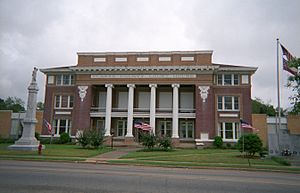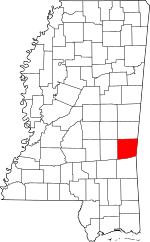Clarke County, Mississippi facts for kids
Quick facts for kids
Clarke County
|
|
|---|---|

Clarke County courthouse and Confederate monument in Quitman
|
|

Location within the U.S. state of Mississippi
|
|
 Mississippi's location within the U.S. |
|
| Country | |
| State | |
| Founded | December 23, 1833 |
| Seat | Quitman |
| Largest city | Quitman |
| Area | |
| • Total | 694 sq mi (1,800 km2) |
| • Land | 692 sq mi (1,790 km2) |
| • Water | 2.0 sq mi (5 km2) 0.3% |
| Population
(2020)
|
|
| • Total | 15,615 |
| • Density | 22.500/sq mi (8.687/km2) |
| Time zone | UTC−6 (Central) |
| • Summer (DST) | UTC−5 (CDT) |
| Congressional district | 3rd |
Clarke County is a county in the state of Mississippi, USA. In 2020, about 15,615 people lived there. The main town, or county seat, is Quitman.
Clarke County is named after Joshua G. Clarke. He was the first state chancellor and judge in Mississippi. The county is also part of the Meridian area.
Contents
History of Clarke County
Before Europeans arrived, the Choctaw Indians lived in the area that is now Clarke County. This land was part of their "Okla Hannali" or "Six Town District." This district existed when the Dancing Rabbit Treaty was signed in 1830.
Around 1820, a Presbyterian minister named David Gage came to the area. He traveled with Moses Jewel and Miss Skinner, who were both teachers. They settled in a place called Eewennans. Their goal was to help educate the Choctaw people and teach them some daily habits.
Early Settlers Arrive
In early 1832, new settlers started moving into the area. This land was known as the "New Purchase." One of the first families to arrive was Jehu and Sarah Pagaus Evans in February 1832. They settled east of Buckatunna Swamp.
By the fall of 1832, many more people arrived quickly. Some of the early settlers included George Evans, Richard Wagster, Henry Hailes, and James Bankston.
Founding the County
Clarke County was officially created in 1833. The county seat, Quitman, was named after General John A. Quitman.
After the county was formed, the first school was built near the old Tennessee Trace. Mr. Hennessy, who came from Ireland, was the teacher. Religious services were held in people's homes or outdoors when the weather was good. The first actual church built was Cedar Creek Church, a Methodist church. Elim Baptist Church was built later in the 1840s.
Choctaw Relocation
In the spring of 1834, Joel Nail, a person of mixed Choctaw and European heritage, began moving the Choctaw Indians. They were moved to Muskalresha, an old town in Neshoba County, Mississippi. These journeys continued until 1838 for those who chose to go. However, some Choctaw Indians returned to their homes in Clarke County after arriving at Muskalresha.
In the 1830s, there were no postal routes directly in Clarke County. People had to travel about 25 miles to Winchester in Wayne County to get their mail. This shows how remote the area was back then.
Geography of Clarke County
The U.S. Census Bureau says that Clarke County covers a total area of 694 square miles (1,797 km²). Out of this, 692 square miles (1,792 km²) is land, and 2.0 square miles (5.2 km²) is water. This means only a small part (0.3%) is water.
The Chickasawhay River flows from north to south through the eastern part of the county. This river eventually joins the Pascagoula River.
Major Highways
 Interstate 59
Interstate 59 U.S. Highway 11
U.S. Highway 11 U.S. Highway 45
U.S. Highway 45 Mississippi Highway 18
Mississippi Highway 18
Neighboring Counties
- Lauderdale County (north)
- Choctaw County, Alabama (east)
- Wayne County (south)
- Jasper County (west)
Population Information
| Historical population | |||
|---|---|---|---|
| Census | Pop. | %± | |
| 1840 | 2,986 | — | |
| 1850 | 5,477 | 83.4% | |
| 1860 | 10,771 | 96.7% | |
| 1870 | 7,505 | −30.3% | |
| 1880 | 15,021 | 100.1% | |
| 1890 | 15,826 | 5.4% | |
| 1900 | 17,741 | 12.1% | |
| 1910 | 21,630 | 21.9% | |
| 1920 | 17,927 | −17.1% | |
| 1930 | 19,679 | 9.8% | |
| 1940 | 20,596 | 4.7% | |
| 1950 | 19,362 | −6.0% | |
| 1960 | 16,493 | −14.8% | |
| 1970 | 15,049 | −8.8% | |
| 1980 | 16,945 | 12.6% | |
| 1990 | 17,313 | 2.2% | |
| 2000 | 17,955 | 3.7% | |
| 2010 | 16,732 | −6.8% | |
| 2020 | 15,615 | −6.7% | |
| 2023 (est.) | 15,228 | −9.0% | |
| U.S. Decennial Census 1790-1960 1900-1990 1990-2000 2010-2013 |
|||
As of the 2020 United States census, there were 15,615 people living in Clarke County. These people lived in 6,237 households, and 4,397 of these were families.
Population by Race (2020)
| Race | Number of People | Percentage |
|---|---|---|
| White | 9,950 | 63.72% |
| Black or African American | 5,103 | 32.68% |
| Native American | 16 | 0.1% |
| Asian | 8 | 0.05% |
| Pacific Islander | 6 | 0.04% |
| Other/Mixed Race | 400 | 2.56% |
| Hispanic or Latino | 132 | 0.85% |
This table shows the different racial and ethnic groups that make up the population of Clarke County, based on the 2020 census.
Ancestry Groups (2017)
In 2017, the largest groups of people based on their family's origin in Clarke County were:
| Largest Ancestries (2017) | Percent |
|---|---|
| English | 22.37% |
| "American" | 10.6% |
| Irish | 7.04% |
| German | 2.65% |
| Dutch | 1.4% |
| Scots-Irish | 1.3% |
| Scottish | 1.1% |
| French (except Basque) | 0.6% |
This table shows where people's families originally came from, according to their self-identification in 2017.
Communities in Clarke County
Clarke County has several towns and communities.
Cities
- Quitman (This is the county seat, meaning it's the main administrative town.)
Towns
Census-designated Place
- De Soto (A place that is like a town but not officially incorporated as one.)
Unincorporated Communities
Ghost Town
- Gin (A town that no longer has many or any residents.)
Education
There are two main school districts in Clarke County:
- Quitman School District
- Enterprise School District
The county is also in the area served by Jones College, which is a community college.
See also
 In Spanish: Condado de Clarke (Misisipi) para niños
In Spanish: Condado de Clarke (Misisipi) para niños

